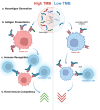The role of neoantigens and tumor mutational burden in cancer immunotherapy: advances, mechanisms, and perspectives
- PMID: 40898324
- PMCID: PMC12406617
- DOI: 10.1186/s13045-025-01732-z
The role of neoantigens and tumor mutational burden in cancer immunotherapy: advances, mechanisms, and perspectives
Abstract
Cancer immunotherapy has revolutionized oncology by leveraging the immune system to combat tumors. Among various biomarkers, neoantigens and tumor mutational burden (TMB) have emerged as critical factors in tailoring personalized treatments. Neoantigens are tumor-specific peptides displayed on cancer cell surfaces, derived from somatic mutations. Recognized as "non-self" by the immune system, they trigger T-cell responses and enable therapies like personalized vaccines and adoptive T-cell transfer. Critically, neoantigen potential correlates with TMB, which quantifies the total somatic mutations within a tumor genome. A higher TMB generally correlates with a greater likelihood of generating immunogenic neoantigens, making it a predictive biomarker for the efficacy of immune checkpoint inhibitors (ICI). Progress in high-throughput sequencing, bioinformatics, and immuno-peptidomics has significantly enhanced the accuracy of neoantigen prediction, including assessments of major histocompatibility complex (MHC) binding affinity and T-cell receptor recognition. Clinically, neoantigen-based therapies have shown efficacy in early trials, with strategies such as mRNA vaccines demonstrating synergy with ICI by boosting T-cell activation and overcoming immune suppression. Combining neoantigen-based therapies with chemotherapy and radiotherapy harnesses synergistic mechanisms to enhance efficacy, overcome resistance, and emerge as a pivotal oncology research focus. The integration of TMB into clinical practice has received regulatory approval as a biomarker for stratifying patients for ICI therapies. Furthermore, advanced methodologies like liquid biopsy and single-cell technologies have streamlined TMB measurement, improving its predictive value for personalized immunotherapy. Collectively, neoantigens and TMB have optimized the evolution of precision immuno-oncology by providing frameworks that maximize therapeutic efficacy, overcome resistance mechanisms, and advance durable cancer remission..
Keywords: Clinical trials; Immunotherapy; Liquid biopsy; Tumor mutational burden; Tumor neoantigens.
© 2025. The Author(s).
Conflict of interest statement
Declarations. Ethics approval and consent to participate: Not applicable. Consent for publication: Not applicable. Competing interests: The authors declare no competing interests.
Figures





Similar articles
-
Interplay between tumor mutation burden and the tumor microenvironment predicts the prognosis of pan-cancer anti-PD-1/PD-L1 therapy.Front Immunol. 2025 Jul 24;16:1557461. doi: 10.3389/fimmu.2025.1557461. eCollection 2025. Front Immunol. 2025. PMID: 40777041 Free PMC article.
-
Of Context, Quality, and Complexity: Fine-Combing Tumor Mutational Burden in Immunotherapy-Treated Cancers.Clin Cancer Res. 2025 Jul 15;31(14):2850-2863. doi: 10.1158/1078-0432.CCR-23-0824. Clin Cancer Res. 2025. PMID: 40353818 Review.
-
Oncolytic reovirus enhances the effect of CEA immunotherapy when combined with PD1-PDL1 inhibitor in a colorectal cancer model.Immunotherapy. 2025 Apr;17(6):425-435. doi: 10.1080/1750743X.2025.2501926. Epub 2025 May 12. Immunotherapy. 2025. PMID: 40353308
-
A phase II randomized trial of individualized neoantigen peptide vaccine combined with unusual radiotherapy (iNATURE) in advanced solid tumors-GCOG0028.Front Immunol. 2025 Aug 21;16:1538032. doi: 10.3389/fimmu.2025.1538032. eCollection 2025. Front Immunol. 2025. PMID: 40918097 Free PMC article. Clinical Trial.
-
A Milestone in the Shift from "Passive Killing" to "Active Immunomodulation" in Cancer Treatment-Progress in Melanoma Vaccine Research.Curr Treat Options Oncol. 2025 Aug;26(8):688-705. doi: 10.1007/s11864-025-01340-6. Epub 2025 Jul 17. Curr Treat Options Oncol. 2025. PMID: 40676479 Review.
References
-
- Gaikwad S, Agrawal MY, Kaushik I, Ramachandran S, Srivastava SK. Immune checkpoint proteins: Signaling mechanisms and molecular interactions in cancer immunotherapy. Semin Cancer Biol. 2022;86:137–50. 10.1016/j.semcancer.2022.03.014. - PubMed
-
- Chen Z, Hu T, Zhou J, Gu X, Chen S, Qi Q, Wang L. Overview of tumor immunotherapy based on approved drugs. Life Sci. 2024;340: 122419. 10.1016/j.lfs.2024.122419. - PubMed
Publication types
MeSH terms
Substances
Grants and funding
- 82202884/National Natural Science Foundation of China
- 2024ZD0520300/Noncommunicable Chronic Diseases-National Science and Technology Major Project
- ZLRK202302/Beijing Hospitals Authority Clinical Medicine Development of special funding support
- 2015BAI13B09/National Key Technologies R&D Program
- 2017YFC0110904/National Key Technologies R&D Program of China
LinkOut - more resources
Full Text Sources
Medical
Research Materials

